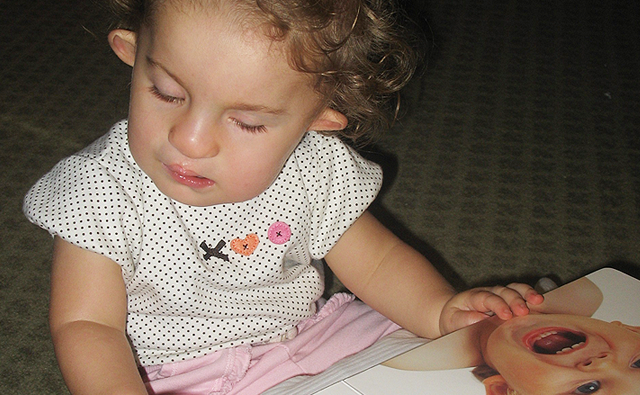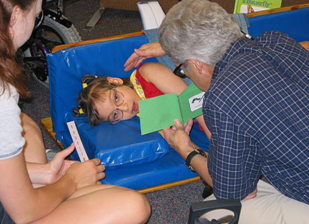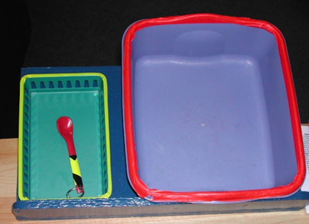Building a Foundation
Literacy is built on the foundation of a child's early relationships and is closely linked to his or her ever-expanding experiences and increasing communication skills. From the day infants are born, they are surrounded by people, objects, and experiences that prepare them to become literate beings. Everyday experiences provide opportunities for them to discover the significance of people, objects, and activities in their environments — to see, hear, touch, smell, and taste new things.
As families, caregivers and professionals our primary role is enabling the child to 'read the world.' (Rosenketter, 2004)

Early on, infants learn to trust family members and caregivers who provide for them daily. Parents and very young children "read" each other's expressions and responses. These interactions with parents and others show children ways to play and have fun as they grow and learn and they form the basis of early communication and social skills. They teach young children that communication is a two-way process that requires a partner. With practice, young children learn that communication also involves initiating an interaction, then expecting, waiting for, and providing a response. They learn that secure, trusting relationships provide an anchor in a world full of new and sometimes frightening experiences.
For children with combined vision and hearing loss, early interactions with people and their environments happen differently. They often miss out on some or all of what happens around them or experience it in a limited or distorted manner. Conversations, daily activities, and learning experiences must take this into account and are likely to occur in non-traditional ways. The presence of someone a child knows, trusts, and can rely on to help provide access to everyday objects and activities is critical in order for learning to occur. It is also important to create unique, individualized, high-interest activities as the basis for literacy learning and to surround the child with family members, teachers, and caregivers who recognize the child's non-verbal communication signals and respond in a consistent manner. It is equally important to remember that if the student has significant physical disabilities, it can be very difficult to balance the physical expectations with the cognitive load.
Related Skills
Literacy skills should not be taught in isolation because they relate to numerous developmental and academic standards often being addressed by a child's educational team. Awareness of interrelated skills assists teams in IEP development and planning holistic instruction.
Attention and Response
Attention/response to environmental stimuli; attention/response to people; attention/response to objects; attention/response to familiar sound/rhythm/movement; awareness of communication partner; joint attention
Interaction and Communication
Response to others; awareness of communication and/or literacy partner; ability to access communication and/or literacy partner; anticipation; turn-taking; use of pre-linguistic forms of communication (touch, object, gestures and/or cues)
Sensory
Use of residual hearing and residual vision to gather information; use of other sensory skills such as smell, taste, movement to gather information; localization to presented sounds; auditory discrimination; response to informational cues; visual fixation; eye gaze; visual shift; tracking of presented objects and/or object permanence
Tactile/Motor
Exploration of items using touch; reach or scan to search for an object; imitation of simple motor tasks; use of hand/fingers to track in preparation for reading braille; use of technology to access print (e.g. adapted keyboard, low vision device)
Cognitive
Recognize familiar objects and people; differentiate between objects and people; differentiate favored objects/people from unfamiliar objects/people; object permanence
Examples
Positioning and presentation of materials
Brianna and her family titled this photo "Learning about bugs." It illustrates the importance of considering where materials are presented and positioning a child for optimum learning. Brianna can concentrate more easily on the book when it's held close and she doesn't have to spend energy working to maintain an upright position in her chair.

Anticipation Calendar
- An association is built between the activity and a
- particular object
- The object is used to represent the entire activity
- Provides the child and communication partner with a
- mutually understood topic
- Introduces the time concepts of past and future
- Provides a sense of security because the child knows what
- will happen next
- Can address unexpected changes in a student's routine

Every Child is a Potential Reader
Newsletter article that provides an excellent introduction to implementing literacy instruction for children with deaf-blindness or other complex learning challenges. (Begins on page 6.)
Video Clips
CELL Model of Early Literacy Development
Five-minute Overview that introduces the Center for Early Literacy Learning's components of early literacy development. The model's components have significance for children regardless of abilities and can be creatively adapted for older children.
Child-Guided Strategies
In this webcast, Dr. Jan van Dijk of the Netherlands shares his expertise related to Child-Guided Assessment.
Conversations: A Personal Reflection About Deafblindness
In this webcast, Barbara Miles discusses her approach to engaging in conversations with students who are deafblind.
Routine-Based Learning
Contains videos demonstrating routines for three different children. Additional information about routines is available by clicking on the other tabs.
Articles
Literacy for Persons Who Are Deaf-Blind
Introduction to an expanded view of literacy, written in everyday language and including a variety of practical tips.
Understanding Deafblindness
A comprehensive overview on Deafblindness.
Talking the Language of the Hands to the Hands
This article describes the importance of hand development for the purposes of exploring and communicating. Includes practical tips on how to teach skills that facilitate hand development and expressiveness.
Strategies for Creating Communication-Rich Environments for Children Who Are Deaf-Blind
Excellent two-page article describing the importance of communication and our role in ensuring that it happens.
Developing Concepts with Children Who Are Deaf-Blind
Practical article that includes useful strategies for promoting concept development.
Communication Matrix
Description of how to use the online Communication Matrix to assess early communication of children with combined vision and hearing loss.
Additional Resources
Module on Communication
This LiveBinder has been created to support educators who work with students with significant disabilities who are acquiring early intentional, symbolic communication skills.
Deafblindness Educational Services Guidelines: Foundations
This introductory chapter provides an excellent overview of fundamental considerations for teaching children with deaf-blindness.
Communication Matrix
An easy-to-use assessment instrument designed for individuals of all ages who function at the earliest stages of communication.
Remarkable Conversations: A Guide to Developing Meaningful Communication with Children and Young Adults Who Are Deafblind
This book is edited by Barbara Miles and Marianne Riggio and published by the Perkins School for the Blind. Available for purchase.
Communication Map
An expressive and receptive Performance Assessment that serves as a visual profile.
Module 2: Overview of Augmentative and Alternative Communication (AAC)
This module provides an overview of AAC and tips for teaching students how to use it.
